17 janv 2026
KCF Est :
Oryzias & Galette des rois.
En savoir +
25-26 janv 2026
KCF Pays de la Loire :
Bourse de Jardres
31 janv 2026
KCF Normandie :
Réunion de section "Galette des Rois"
En savoir +
31 janv - 1 fév
Section Pyrénées :
Bourse de Blagnac
8-10 mai 2026
SEK Espagne :
Congrès de la SEK 2026
14-17 mai 2026
Allemagne DKG :
Congrès de la DKG 2026
25-27 sep 2026
KCF France :
52ème congrès du KCF
Fermer 
Accueil
Qu'est ce que le KCF ?
Les sections régionales
Les congrès du KCF
Contacter le KCF
L'agenda du KCF
Les liens du KCF
Challenge Européen Killiphile
Débuter avec les killies
Les actualités du KCF
Interviews d'éleveurs
Bricolage et astuces
Nourriture
Voyages / Expéditions Killi Expert
Annonces
Voyages / Expéditions Killi Expert
- Accueil
- Le forum du KCF
- Les killies : maintenance, reproduction et élevage
- Aphanius mento Zengen
Aphanius mento Zengen
Les killies : maintenance, reproduction et élevage

Le 27 avril 2011 à 20h25

BigC
Le 27 avril 2011 à 20h25
[b]Encore une fois je m'excuse pour ce qui est en anglais[/b]

[b]A Persian Jewel[/b]
A personal account surrounding the husbandry of
Aphanius mento Zengen
By
Colin McCourt
Introduction
First described by Heckel in 1843 suggests that this species has been known to mankind for well over 150 years now but it has not been widely kept and bred by hobbyists until more recent times. Most killifish enthusiasts shying away from European and Mid Eastern genres due to the apparent lack of vivid colouration, preferring instead to opt for the wow factor of the African genre’s such as Aphyosemion & Nothobranchius. Today, aquarist’s awareness in habitat devastation and destruction seems to have increased the popularity of Aphanius and related European genre’s of this ilk and rightly so.
Natural History
The geographical distribution of this little jewel is pretty vast by all accounts, ranging from the Dead Sea and Jordan Valley in Israel up through Lebanon and Syria into south central Turkey and then down the Euphrates and Tigris river valleys into the Shat al Arab marshes near the Persian Gulf. Most populations prevalent in the hobby today seem to emanate from Turkey, most noticeably being the “Kirk Goz Spring” population. Whilst a great number of species from the Aphanius genre come from coastal waterways that are considered marine to brackish in their make-up, this species in question inhabits bodies of water such as springs, creeks, rivers, and small lakes which are considered by nature to be freshwater to slightly brackish, where here it lives in the shallows of the water’s edge amongst heavy vegetation to avoid predation and to establish breeding territories.

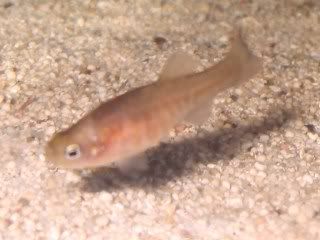
[b]Images of male and female[/b].
Aquisition & initial thoughts
As mentioned earlier, as a killifish enthusiast, I would have never even given a second thought to keeping any of the European – Mid Eastern species of toothcarp. Through ignorance and considering them to be a poor man’s version of what was coming out of Africa and South America. I think this very fact is or was most folk’s perception on this topic, so I don’t think I was alone in this line of thinking. I knew they had their following but I perceived it to being only a small minority of enthusiasts in a pretty much niche area of killi-keepers.
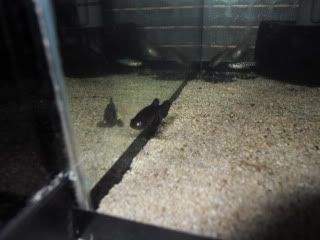
[b]The male just wont keep still[/b].
Tanks and Equipment
As mentioned previously, I wasn’t really affording or devoting much interest in this little group up until the point of the male colouring up. I gave them a small tank (they themselves were only small) measuring 12x8x8. Knowing that they needed pretty hard water, I used 100% local tap-water for this and added some aragonite sand as a base. A small air driven sponge filter was added alongside a floating mop. Their quarters were sandwiched between two heated aquaria so the only heat they would get in my garage would be what they could gather from these other tanks. They were provided with no artificial lighting. The only indirect form of light that gets to the tank is from the garage window
Water Conditions
Our local Tap-water, whilst not ideal, is very hard and has a pH of around 7.6 so this, naturally, was what I was going to use.
A little conditioner was added to their water-changes alongside a spoon full of cooking salt and that was basically it as far as providing them with any specialist treatment. They seemed to like the environment in which they were living, the temperature of the water would be in the region of 60’F and they seem well adapted to this, as they are pretty active, they don’t stop and lounge around like most killifish I’d kept previously, always darting around the tank.
Diet
Now, with taking a more vested interest in this fish I feed them predominately live-food, whereas before, when they were smaller, I was using spurilina and staple flake. They now enjoy morsels such as Fruitfly, Grindal & Whiteworm, Newly hatched Brineshrimp and Moina macrocopa whilst still retaining some element of vegetable matter in their diet through the dried food.
Temperament
The males of this little fish, for its size, seems to have developed quite a reputation for being aggressive, with reports of rival males being battered to death alongside unresponsive females, even some accounts of them being used as dither fish with cichlids and being more than capable of holding their own.
Whilst I cannot speak for all the locational varieties of this species, the contingent from Zengen (and I may live to eat my words) must be quite placid by comparison. Currently, in the small confines of their tank I now have 3 large females, one dominant male and a smaller male (both coloured up). I lost one of the original six early on, it being the runt.
Barring the odd short chase I have witnessed no real aggression as such, not yet anyway. The fish are what I would consider “still only young”, and maybe this aggressive trait will manifest itself later on as the fish mature somewhat, I will have to wait and see. For the meantime all is pretty much peaceful.
Breeding
Taking heed of all the literature I’ve gathered especially my observations from their temperament, I decided to keep them as a group and spawn them (if I could) as such. Noticing that I was getting the odd egg here and there I decided that it was time to include another mop (sunken). I would observe that the only eggs being laid would be attached to the very bottom of the floating mop right at the point where they touched the aragonite sand base. I have, to date not had any eggs other than this locality, not even on the sunken mop. Now I know that this species will predate their own eggs and young so a daily collection of eggs must be performed if one hopes to gather some stock for the next generation. The male will keep close to and circle the lower regions of the mop and will entice the females into his little domain to spawn, he will only venture away from this point to quickly feed and dart straight back to his territory. The females on the other hand remain for the most part in open water and are not as timid or highly strung as the male.

[b]An egg from Aphanius mento Zengen (Turkey)[/b]
Over the winter in the garage I was not getting any eggs at all, albeit the fish were still young. It is only now with the advent of Spring that everything has sprung into life, which, as suspected, this species may be considered as a seasonal spawner.
The eggs of Aphanius mento (from this location at least) are very small, they are laid singally and also in very sticky strands of around three, they are a very clear egg with no signs of colouration. As mentioned earlier I collect the eggs on a daily basis and place them in a small margarine tub with the same water as the parent tank. I like to add a few grains of salt at this point to try and keep fungus at bay. Here the eggs mature for around 1-2 weeks before they hatch, please note that this can vary quite a lot as this is temperature dependant.
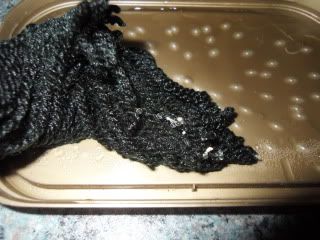

[b]Egg clusters of A. mento at the extreme ends of a floating mop[/b].
I now remove the newly hatched fry with a pipette to a fresh tub of water of the same quality and begin feeding, three times per day. Surprisingly enough the fry from such a small egg are able to consume newly hatched brine-shrimp straight away. As always keep the fry tubs clean and remove any uneaten shrimp or otherwise daily. Small water changes can be performed as you do do.
[youtube]http://www.youtube.com/watch?v=nODvTVCAWag[/youtube]
[b]A short video of an egg of this species, note: the eye and below the heart beating away[/b]
The fry of this species take a long time to mature. They took ages to grow and acquire colour, perhaps around six months in total. It may well be that a higher temperature would have some effect at foreshortening this, but from my observation at a mean low Winter temp until its natural progression into Spring, this was what I personally witnessed.
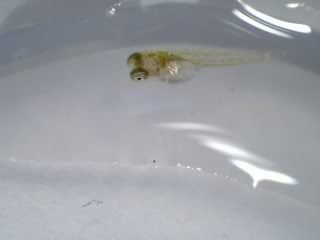
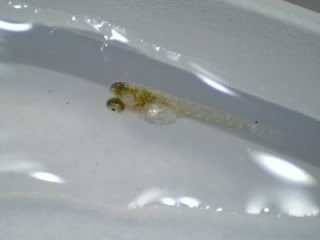
[b]Two day old " A. mento" fry.[/b]
Summary
This little beauty is a true gem, perhaps not given as much attention as it deserves. The colouration of the males in breeding apparel is truly a sight to behold. I was admittedly one of those many killifish fanciers around the globe that leant toward keeping the more colourful African and South American genus of toothcarp, not giving a second thought to keeping Killifish, that were, for some part, closer to home. These killifish genre’s deserve a mention more hobbyists to take an interest in them for they are experiencing the same problems and tribulations that their counterparts are experiencing in other more climatic parts of the globe, their habitats are being destroyed through various anomalies, mostly man-made. Some are extinct in the wild and some are teetering very close to the edge. So I urge folks to spare a thought for these fishes, their background, and their plight and to maybe set aside a small tank in a cool corner of their fish-house to keep these little gems from disappearing altogether. A cold water killifish species with No electricity usage to speak of what more could a killi-fancier want in these hard times.
I hope you all enjoyed this personal account on this lovely little “Persian Jewel”.
Regards
C

[b]A Persian Jewel[/b]
A personal account surrounding the husbandry of
Aphanius mento Zengen
By
Colin McCourt
Introduction
First described by Heckel in 1843 suggests that this species has been known to mankind for well over 150 years now but it has not been widely kept and bred by hobbyists until more recent times. Most killifish enthusiasts shying away from European and Mid Eastern genres due to the apparent lack of vivid colouration, preferring instead to opt for the wow factor of the African genre’s such as Aphyosemion & Nothobranchius. Today, aquarist’s awareness in habitat devastation and destruction seems to have increased the popularity of Aphanius and related European genre’s of this ilk and rightly so.
Natural History
The geographical distribution of this little jewel is pretty vast by all accounts, ranging from the Dead Sea and Jordan Valley in Israel up through Lebanon and Syria into south central Turkey and then down the Euphrates and Tigris river valleys into the Shat al Arab marshes near the Persian Gulf. Most populations prevalent in the hobby today seem to emanate from Turkey, most noticeably being the “Kirk Goz Spring” population. Whilst a great number of species from the Aphanius genre come from coastal waterways that are considered marine to brackish in their make-up, this species in question inhabits bodies of water such as springs, creeks, rivers, and small lakes which are considered by nature to be freshwater to slightly brackish, where here it lives in the shallows of the water’s edge amongst heavy vegetation to avoid predation and to establish breeding territories.


[b]Images of male and female[/b].
Aquisition & initial thoughts
As mentioned earlier, as a killifish enthusiast, I would have never even given a second thought to keeping any of the European – Mid Eastern species of toothcarp. Through ignorance and considering them to be a poor man’s version of what was coming out of Africa and South America. I think this very fact is or was most folk’s perception on this topic, so I don’t think I was alone in this line of thinking. I knew they had their following but I perceived it to being only a small minority of enthusiasts in a pretty much niche area of killi-keepers.

[b]The male just wont keep still[/b].
Tanks and Equipment
As mentioned previously, I wasn’t really affording or devoting much interest in this little group up until the point of the male colouring up. I gave them a small tank (they themselves were only small) measuring 12x8x8. Knowing that they needed pretty hard water, I used 100% local tap-water for this and added some aragonite sand as a base. A small air driven sponge filter was added alongside a floating mop. Their quarters were sandwiched between two heated aquaria so the only heat they would get in my garage would be what they could gather from these other tanks. They were provided with no artificial lighting. The only indirect form of light that gets to the tank is from the garage window
Water Conditions
Our local Tap-water, whilst not ideal, is very hard and has a pH of around 7.6 so this, naturally, was what I was going to use.
A little conditioner was added to their water-changes alongside a spoon full of cooking salt and that was basically it as far as providing them with any specialist treatment. They seemed to like the environment in which they were living, the temperature of the water would be in the region of 60’F and they seem well adapted to this, as they are pretty active, they don’t stop and lounge around like most killifish I’d kept previously, always darting around the tank.
Diet
Now, with taking a more vested interest in this fish I feed them predominately live-food, whereas before, when they were smaller, I was using spurilina and staple flake. They now enjoy morsels such as Fruitfly, Grindal & Whiteworm, Newly hatched Brineshrimp and Moina macrocopa whilst still retaining some element of vegetable matter in their diet through the dried food.
Temperament
The males of this little fish, for its size, seems to have developed quite a reputation for being aggressive, with reports of rival males being battered to death alongside unresponsive females, even some accounts of them being used as dither fish with cichlids and being more than capable of holding their own.
Whilst I cannot speak for all the locational varieties of this species, the contingent from Zengen (and I may live to eat my words) must be quite placid by comparison. Currently, in the small confines of their tank I now have 3 large females, one dominant male and a smaller male (both coloured up). I lost one of the original six early on, it being the runt.
Barring the odd short chase I have witnessed no real aggression as such, not yet anyway. The fish are what I would consider “still only young”, and maybe this aggressive trait will manifest itself later on as the fish mature somewhat, I will have to wait and see. For the meantime all is pretty much peaceful.
Breeding
Taking heed of all the literature I’ve gathered especially my observations from their temperament, I decided to keep them as a group and spawn them (if I could) as such. Noticing that I was getting the odd egg here and there I decided that it was time to include another mop (sunken). I would observe that the only eggs being laid would be attached to the very bottom of the floating mop right at the point where they touched the aragonite sand base. I have, to date not had any eggs other than this locality, not even on the sunken mop. Now I know that this species will predate their own eggs and young so a daily collection of eggs must be performed if one hopes to gather some stock for the next generation. The male will keep close to and circle the lower regions of the mop and will entice the females into his little domain to spawn, he will only venture away from this point to quickly feed and dart straight back to his territory. The females on the other hand remain for the most part in open water and are not as timid or highly strung as the male.

[b]An egg from Aphanius mento Zengen (Turkey)[/b]
Over the winter in the garage I was not getting any eggs at all, albeit the fish were still young. It is only now with the advent of Spring that everything has sprung into life, which, as suspected, this species may be considered as a seasonal spawner.
The eggs of Aphanius mento (from this location at least) are very small, they are laid singally and also in very sticky strands of around three, they are a very clear egg with no signs of colouration. As mentioned earlier I collect the eggs on a daily basis and place them in a small margarine tub with the same water as the parent tank. I like to add a few grains of salt at this point to try and keep fungus at bay. Here the eggs mature for around 1-2 weeks before they hatch, please note that this can vary quite a lot as this is temperature dependant.


[b]Egg clusters of A. mento at the extreme ends of a floating mop[/b].
I now remove the newly hatched fry with a pipette to a fresh tub of water of the same quality and begin feeding, three times per day. Surprisingly enough the fry from such a small egg are able to consume newly hatched brine-shrimp straight away. As always keep the fry tubs clean and remove any uneaten shrimp or otherwise daily. Small water changes can be performed as you do do.
[youtube]http://www.youtube.com/watch?v=nODvTVCAWag[/youtube]
[b]A short video of an egg of this species, note: the eye and below the heart beating away[/b]
The fry of this species take a long time to mature. They took ages to grow and acquire colour, perhaps around six months in total. It may well be that a higher temperature would have some effect at foreshortening this, but from my observation at a mean low Winter temp until its natural progression into Spring, this was what I personally witnessed.


[b]Two day old " A. mento" fry.[/b]
Summary
This little beauty is a true gem, perhaps not given as much attention as it deserves. The colouration of the males in breeding apparel is truly a sight to behold. I was admittedly one of those many killifish fanciers around the globe that leant toward keeping the more colourful African and South American genus of toothcarp, not giving a second thought to keeping Killifish, that were, for some part, closer to home. These killifish genre’s deserve a mention more hobbyists to take an interest in them for they are experiencing the same problems and tribulations that their counterparts are experiencing in other more climatic parts of the globe, their habitats are being destroyed through various anomalies, mostly man-made. Some are extinct in the wild and some are teetering very close to the edge. So I urge folks to spare a thought for these fishes, their background, and their plight and to maybe set aside a small tank in a cool corner of their fish-house to keep these little gems from disappearing altogether. A cold water killifish species with No electricity usage to speak of what more could a killi-fancier want in these hard times.
I hope you all enjoyed this personal account on this lovely little “Persian Jewel”.
Regards
C

Le 27 avril 2011 à 20h59

Chromaphyo
Le 27 avril 2011 à 20h59
C'est exact. Comme la plupart des [i]Aphanius[/i], ils sont saisonniers.
Excellent texte. Merci La population de Zengen montre un patron plus ou moins "classique".
Aurais tu d'autres photos ?
Quelle est la taille des femelles et des mâles ?
Je pense que la souche de Kir Göz Spring est nettement plus grande et d'un phénotype assez aberrant (points plus nombreux et disposés de façon moins uniforme).

Le 27 avril 2011 à 21h19

BigC
Le 27 avril 2011 à 21h19
The males I have at the moment are around 50mm with the females slightly larger 55mm
I don't have any more images at the moment but I can take some for you shortly if required.
Females are easy to photograph but the males remain much more alert and timid.
the "Kirk Goz" strain may well be larger, I know that certain populations attain different sizes, Zengen may well be one of the smaller ones.
Regards
Colin
I don't have any more images at the moment but I can take some for you shortly if required.
Females are easy to photograph but the males remain much more alert and timid.
the "Kirk Goz" strain may well be larger, I know that certain populations attain different sizes, Zengen may well be one of the smaller ones.
Regards
Colin

Le 28 avril 2011 à 13h52

Le 29 avril 2011 à 14h47

Aphaniomaniak
Le 29 avril 2011 à 14h47
... et si Colin est d'accord, pourquoi ne pas traduire le texte en français pour le KR ??? (je serais [i]OK[/i] pour le faire tiens !)
... and if Colin agrees, why not use this text translated in French for the Killi-Revue ??? (I will be [i]d'accord[/i] to do it, eh !)
... and if Colin agrees, why not use this text translated in French for the Killi-Revue ??? (I will be [i]d'accord[/i] to do it, eh !)

Le 29 avril 2011 à 17h15

Le 29 avril 2011 à 17h42

Aphaniomaniak
Le 29 avril 2011 à 17h42
ah bah dommage Jean-François... pour une fois que j'étais prêt à faire kikchose... :laugh: je me réveillerai en 2017 la prochaine fois ... :angel:

Le 06 mai 2011 à 22h02

BigC
Le 06 mai 2011 à 22h02
I have just purchased a new LCD Microscope and whilst I'm getting to grips with its finer points, I am going to use this subject matter for a series of daily microscopic images on an egg from this species.
Below is the first of the pictures taken with the scope, The subject is an egg of [b]Aphanius mento Zengen[/b] and was taken with a Bresser Microscope at 10x (640x480)

[color=red]Day1[/color] (Collection) The nucleus appears to have already divided the once.
I hope to carry this experiment on until the egg eventually hatches which should satisfy two aims. (a) to show what goes on inside a fertilised killifish egg and the embryo in its early developmental stages...(b) it enables me to learn more about the working of this new scope.
Regards
Colin
Below is the first of the pictures taken with the scope, The subject is an egg of [b]Aphanius mento Zengen[/b] and was taken with a Bresser Microscope at 10x (640x480)

[color=red]Day1[/color] (Collection) The nucleus appears to have already divided the once.
I hope to carry this experiment on until the egg eventually hatches which should satisfy two aims. (a) to show what goes on inside a fertilised killifish egg and the embryo in its early developmental stages...(b) it enables me to learn more about the working of this new scope.
Regards
Colin

Le 07 mai 2011 à 16h41

BigC
Le 07 mai 2011 à 16h41
Egg development of the killifish egg is, for me at least, a very interesting topic, one in which I wish to learn a lot more and study the various stages in a little more depth, the timings, the nomenclature and any other details that go alongside this.
The time it takes for an Aphanius mento egg to completely mature is given in or around two weeks, give or take, and is temperature dependant. So little wonder that not much has happened in the last 24 hours. Well when I mean not much has happened, I use that term very loosely indeed as although there is perhaps little difference to the naked eye, when scrutinised under the microscope things are a whole lot different.
As life inside this Aphanius egg would seem a little slow as cells move, adjust and start to function, I should really include a shot from a little farther away but this will act in tandem with the micro close-up images and videos to come.
In this earliest developmental stage of the fertilized ovum (ZYGOTE) there are several mitotic divisions within the membrane. Each cleavage or segmentation yields two BLASTOMERES of about half size of the parent cell.

[color=red]Day 2[/color] (i) Shows the egg from a little distance away.
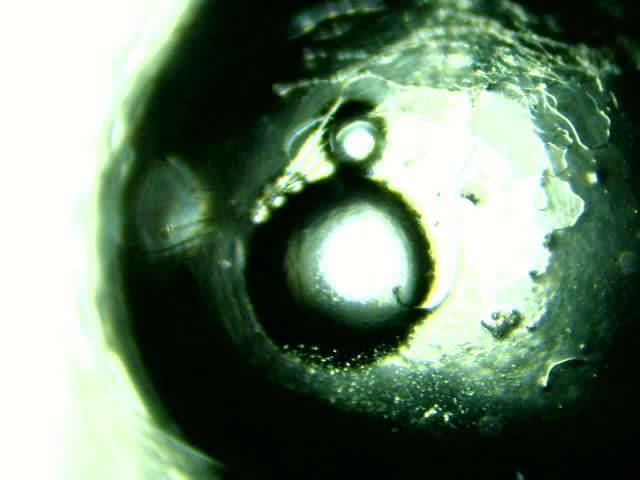
(ii) Same shot utilising the main scope. Cell division seems to be continuing apace.
As yet I am unfamiliar with many of the names of the certain sectors of the egg so I wouldn't want to mislead anyone by wrongly adding a name to these areas until I research more, after which I can come back to this and fill in the blanks.
In the mean time if anyone would like to jump in and educate me on this aspect, I'm all ears and willing to learn.
Regards
C
The time it takes for an Aphanius mento egg to completely mature is given in or around two weeks, give or take, and is temperature dependant. So little wonder that not much has happened in the last 24 hours. Well when I mean not much has happened, I use that term very loosely indeed as although there is perhaps little difference to the naked eye, when scrutinised under the microscope things are a whole lot different.
As life inside this Aphanius egg would seem a little slow as cells move, adjust and start to function, I should really include a shot from a little farther away but this will act in tandem with the micro close-up images and videos to come.
In this earliest developmental stage of the fertilized ovum (ZYGOTE) there are several mitotic divisions within the membrane. Each cleavage or segmentation yields two BLASTOMERES of about half size of the parent cell.

[color=red]Day 2[/color] (i) Shows the egg from a little distance away.

(ii) Same shot utilising the main scope. Cell division seems to be continuing apace.
As yet I am unfamiliar with many of the names of the certain sectors of the egg so I wouldn't want to mislead anyone by wrongly adding a name to these areas until I research more, after which I can come back to this and fill in the blanks.
In the mean time if anyone would like to jump in and educate me on this aspect, I'm all ears and willing to learn.
Regards
C

Le 09 mai 2011 à 20h37

BigC
Le 09 mai 2011 à 20h37
Today there seems to be three distinct spheres within the egg casing. One large (which was always there) and two smaller daughter spheres which have split from the mother. They appear to be moving farther away from the main globe, outward toward the rim of the egg.
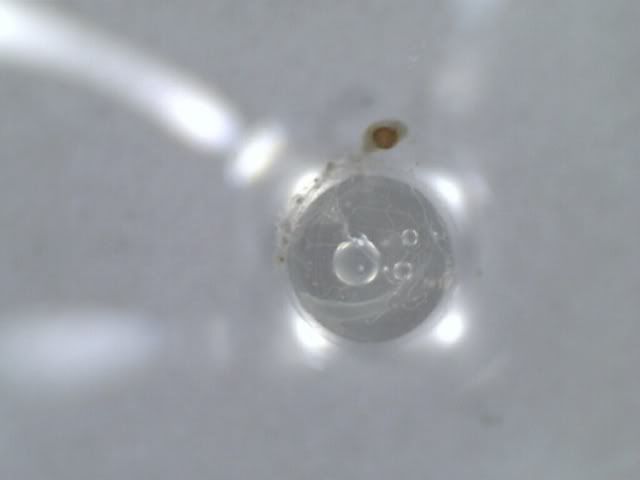
The spheres are clearly moving into a preordained position

[color=red]Day 3[/color] Again I have included two views so as you can ascertain what is exactly happening.
Procedures are happening at a pretty slow pace compared to fish eggs which take a shorter time to hatch.
Regards
C

The spheres are clearly moving into a preordained position

[color=red]Day 3[/color] Again I have included two views so as you can ascertain what is exactly happening.
Procedures are happening at a pretty slow pace compared to fish eggs which take a shorter time to hatch.
Regards
C

Le 09 mai 2011 à 20h38

BigC
Le 09 mai 2011 à 20h38
Yesterday I had concerns that this egg was not going to turn out to be viable... but I needn't have worried.
What a difference 24 hours makes. I think you'll all agree that the transformation between day three and day four is nothing less than astonishing.
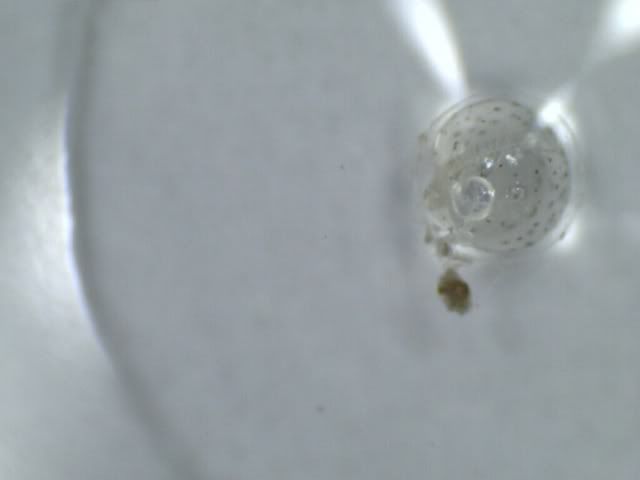
[color=red]Day 4[/color] If you look closely the backbone has started to form and can be see spread across the inside of the egg just above the larger globe. Interestingly also that the speckling has started to form which is evident in all the killifish eggs I have studied so far. I have had suggestions as to what this is but need to find out a little more on the subject.
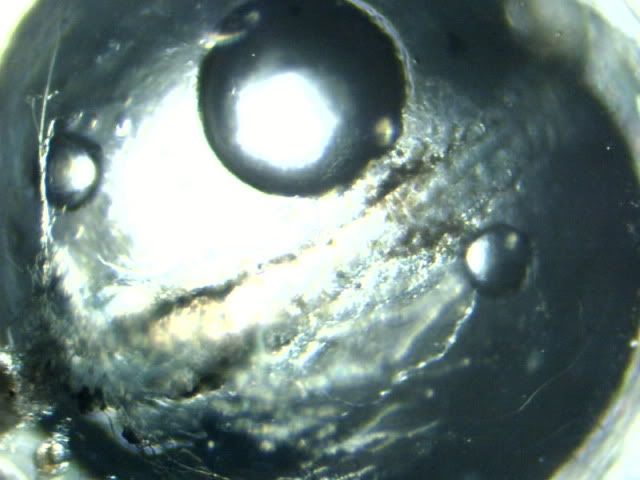
From the microscope shot, again the backbone is clearly visible running around the circumference of the egg sack from 2 O'clock to 8 O'clock.
Such a difference in embryonic development in just one day
Regards
C
What a difference 24 hours makes. I think you'll all agree that the transformation between day three and day four is nothing less than astonishing.

[color=red]Day 4[/color] If you look closely the backbone has started to form and can be see spread across the inside of the egg just above the larger globe. Interestingly also that the speckling has started to form which is evident in all the killifish eggs I have studied so far. I have had suggestions as to what this is but need to find out a little more on the subject.

From the microscope shot, again the backbone is clearly visible running around the circumference of the egg sack from 2 O'clock to 8 O'clock.
Such a difference in embryonic development in just one day
Regards
C

Le 10 mai 2011 à 22h37

BigC
Le 10 mai 2011 à 22h37
Again today there has been massive changes to this egg. For the first time we see animation within the egg casing as the heart starts to form and pump fluids around the body. Now we may witness the start of probable accelerated development of this particular fry.
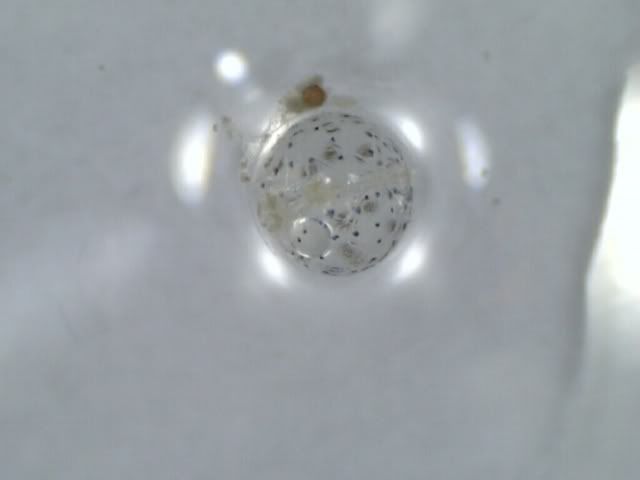
[color=red]Day 5[/color] Again one can clearly see the fry lying across the inside of the egg sac.
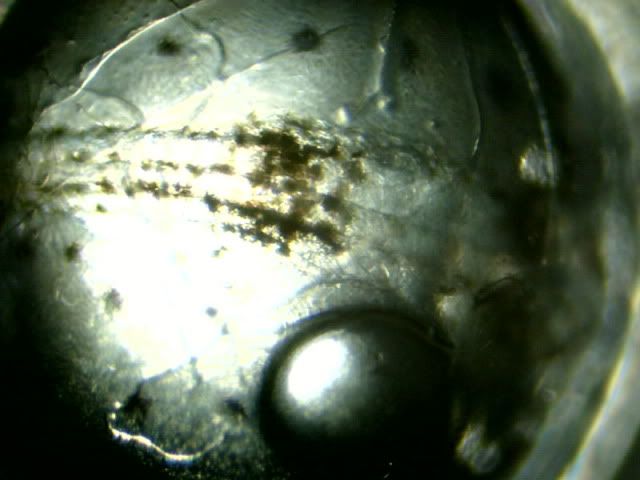
Getting in a little closer.
Now that this embryo has become animated with the resemblance of a heartbeat, I feel we must include video clips.
Aphanius mento embryo Day 5
The pumping station has started to function, moving fluids around to key organs.
Regards
C

[color=red]Day 5[/color] Again one can clearly see the fry lying across the inside of the egg sac.

Getting in a little closer.
Now that this embryo has become animated with the resemblance of a heartbeat, I feel we must include video clips.
Aphanius mento embryo Day 5
The pumping station has started to function, moving fluids around to key organs.
Regards
C

Le 11 mai 2011 à 20h15

BigC
Le 11 mai 2011 à 20h15
The sixth day in the life cycle of this egg see's a little more growth and stronger heart rhythms....
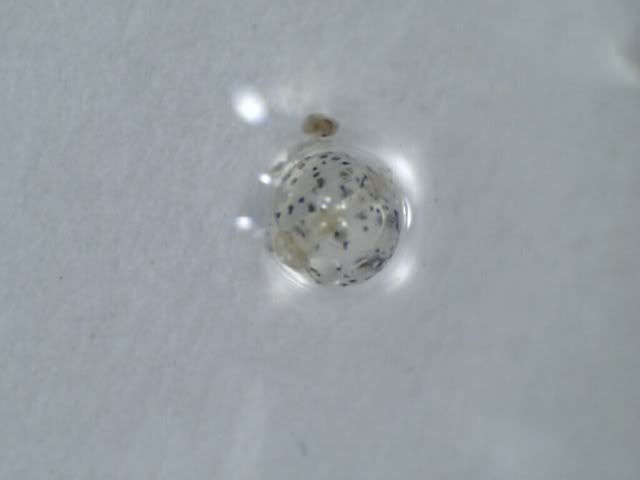
[color=red]Day 6[/color] The egg has gone from being almost a perfect sphere to slightly oblong in appearance.
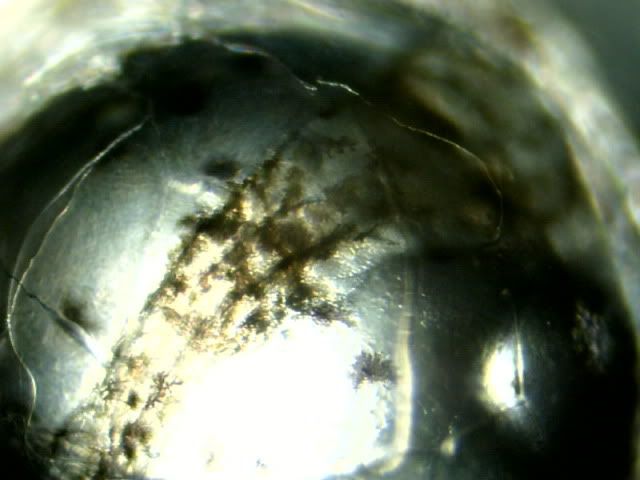
The microscopic view
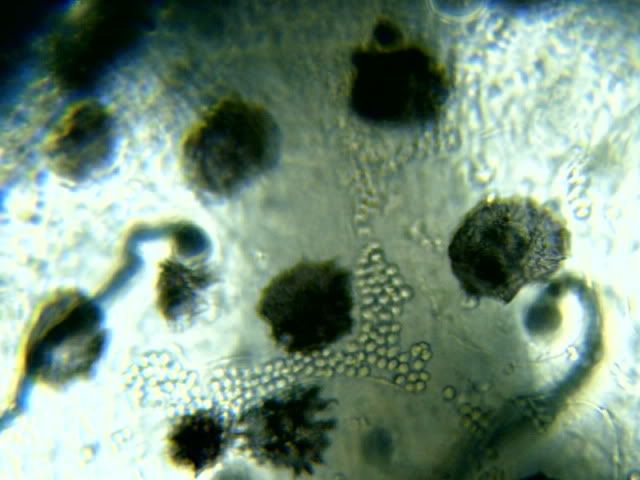
A close-up of the blotches of pigmentation, prevalent over the whole of the embryo
Aphanius mento embryo Day 6
The heartbeat is strengthening and the fluids are flowing with more urgency today.
Regards
Colin

[color=red]Day 6[/color] The egg has gone from being almost a perfect sphere to slightly oblong in appearance.

The microscopic view

A close-up of the blotches of pigmentation, prevalent over the whole of the embryo
Aphanius mento embryo Day 6
The heartbeat is strengthening and the fluids are flowing with more urgency today.
Regards
Colin

Le 12 mai 2011 à 22h51

BigC
Le 12 mai 2011 à 22h51
Day 7....and some of the features are now becoming quite distinguishable.
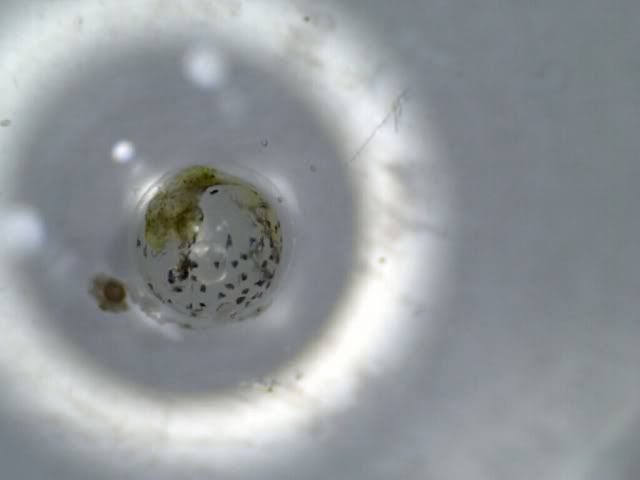
[color=red]Day 7[/color] The head of the fry is much more noticeable today and the eyes are starting to form
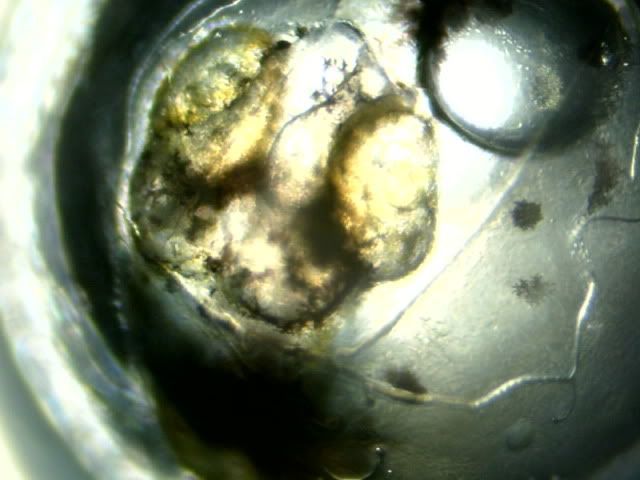
Another shot of the head and eyes from a closer range
http://www.youtube.com/watch?v=AAQAJttZh5Q#
And how about this...The eye sockets are to the left and right of the picture with the mouth parts at the top of the screen. The heart is doing an amazing job at pumping all the necessary materials around the body of the embryo.
Regards
Colin

[color=red]Day 7[/color] The head of the fry is much more noticeable today and the eyes are starting to form

Another shot of the head and eyes from a closer range
http://www.youtube.com/watch?v=AAQAJttZh5Q#
And how about this...The eye sockets are to the left and right of the picture with the mouth parts at the top of the screen. The heart is doing an amazing job at pumping all the necessary materials around the body of the embryo.
Regards
Colin

Le 13 mai 2011 à 18h34

BigC
Le 13 mai 2011 à 18h34
[b][u]On to Day eight![/u][/b]
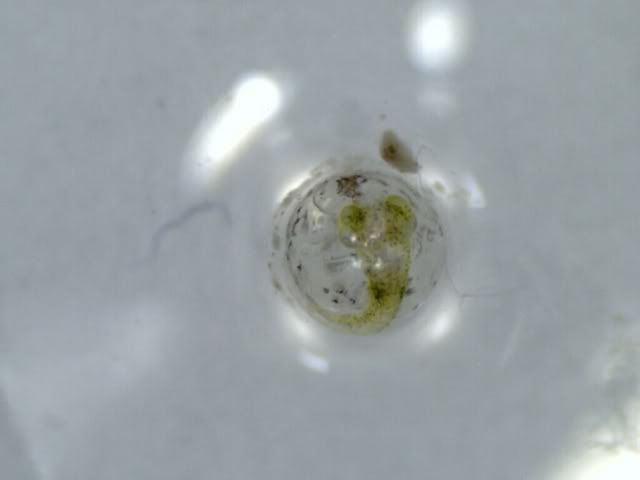
[color=red]Day 8[/color] Today's overview shot again see's the embryo lying through the centre of the egg casing. although a little larger, the embryo itself is much more animated and is able to move and turn within the egg sac.
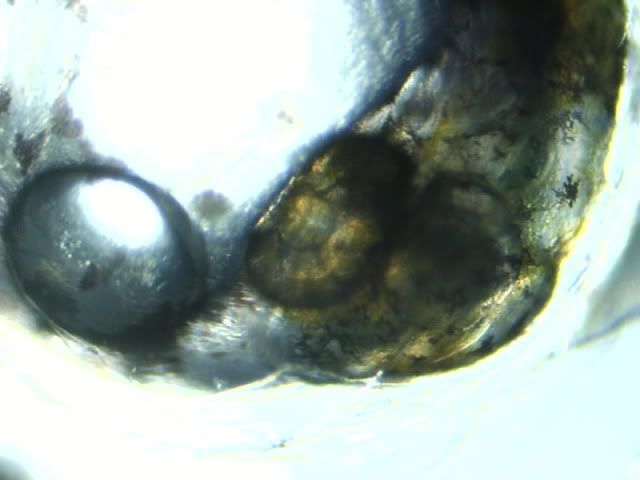
The microscopic image shows the "Oil Drop" with the head of the embryo in close proximity.
For the video of day eight's egg development, I thought we'd try a little something different, I wondered if I could circumnavigate the whole egg, to display exactly what is going on inside various areas of the egg sac.....see what you think.
Aphanius mento embryo Day 8
We start by looking at the "Oil Drop" (which is spare food for the embryo. It becomes part of the yolk bag (the belly) of the embryo) next we move past the heart and the eye area...onward over the back of the head and move upward, round and over the dorsal area, (notice a great deal of fluids being pumped around this area) continuing anticlockwise until we reach the tail area and return back to the "Oil Drop" from once we started.
This is only a short video but I hope it gives you all some insight into a world that we maybe take for granted, to see what really goes behind the scenes as it were, whilst we wait for the fry to break free from it's confines of the egg casing.
Regards
Colin

[color=red]Day 8[/color] Today's overview shot again see's the embryo lying through the centre of the egg casing. although a little larger, the embryo itself is much more animated and is able to move and turn within the egg sac.

The microscopic image shows the "Oil Drop" with the head of the embryo in close proximity.
For the video of day eight's egg development, I thought we'd try a little something different, I wondered if I could circumnavigate the whole egg, to display exactly what is going on inside various areas of the egg sac.....see what you think.
Aphanius mento embryo Day 8
We start by looking at the "Oil Drop" (which is spare food for the embryo. It becomes part of the yolk bag (the belly) of the embryo) next we move past the heart and the eye area...onward over the back of the head and move upward, round and over the dorsal area, (notice a great deal of fluids being pumped around this area) continuing anticlockwise until we reach the tail area and return back to the "Oil Drop" from once we started.
This is only a short video but I hope it gives you all some insight into a world that we maybe take for granted, to see what really goes behind the scenes as it were, whilst we wait for the fry to break free from it's confines of the egg casing.
Regards
Colin

Le 14 mai 2011 à 20h19

BigC
Le 14 mai 2011 à 20h19
[b]Another day in the life of the developing egg of Aphanius mento[/b]
Today there is another marked increase in fluids coursing around the inside of this growing embryo, most noticeably through the Oil Drop and Heart area. The biological pumping station forces these fluids to where they are needed to enable the fry to grow and function in readiness for life on the outside.
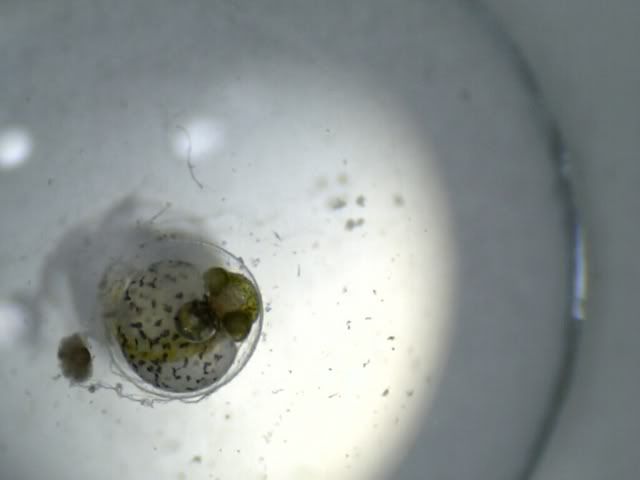
[color=#FF0000]Day 9[/color] Our overview image from this evening shows up pretty much like an ariel shot with the forming eyes, the snout and the Oil Drop all in clear view
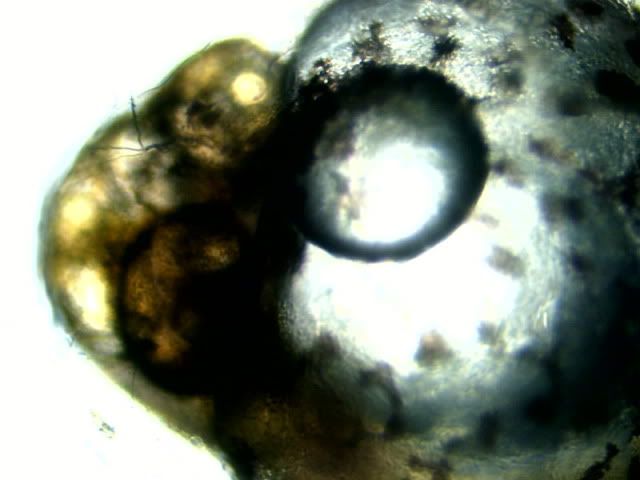
From the microscopic perspective we focus in on the head area.
http://www.youtube.com/watch?v=xYyJp0uMEZc#
Staying on theme, in today's video clip we zoom in on the "Heart" of the embryo.
In constant motion, a massive amount of fluids are perpetually entering and exiting this vital organ
The darken sphere to the top right is the "Oil Drop" , which today, was a place of great animation.
This little fella has been poked and prodded around inside his/her protective casing for over a week now, bright lights have shone on it from all angles and still life must go on...........
Regards
C
Today there is another marked increase in fluids coursing around the inside of this growing embryo, most noticeably through the Oil Drop and Heart area. The biological pumping station forces these fluids to where they are needed to enable the fry to grow and function in readiness for life on the outside.

[color=#FF0000]Day 9[/color] Our overview image from this evening shows up pretty much like an ariel shot with the forming eyes, the snout and the Oil Drop all in clear view

From the microscopic perspective we focus in on the head area.
http://www.youtube.com/watch?v=xYyJp0uMEZc#
Staying on theme, in today's video clip we zoom in on the "Heart" of the embryo.
In constant motion, a massive amount of fluids are perpetually entering and exiting this vital organ
The darken sphere to the top right is the "Oil Drop" , which today, was a place of great animation.
This little fella has been poked and prodded around inside his/her protective casing for over a week now, bright lights have shone on it from all angles and still life must go on...........
Regards
C

Le 15 mai 2011 à 18h59

BigC
Le 15 mai 2011 à 18h59
[b]Day 10, and the juices are still flowing......[/b]
Today sees another dramatic increase in the shape of the egg, it seems to be a little wider and more robust looking as the embryo grows inside. Another noticeable fact is that the heavy dark blotches have not totally disappeared but have taken on different shapes and faded a little.
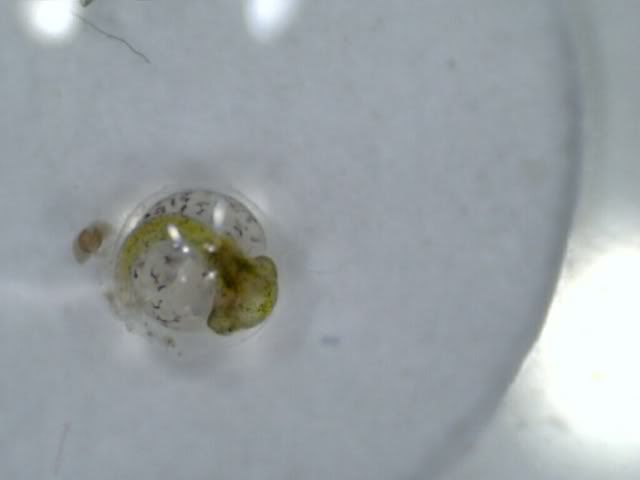
[color=red]Day 10[/color] The overall view today concentrates on the back of the head and over the spine (dorsal), still looks to be a long way to go before actual definition of the eyes and other body parts start to occur
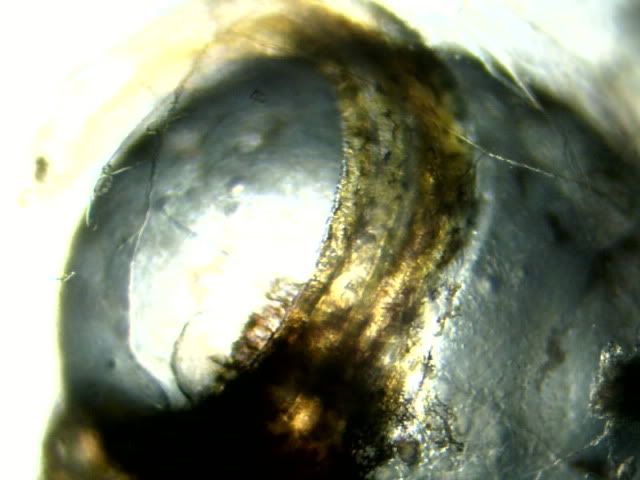
Microscopically, again we are looking at the spine of the embryo, just behind the head.
http://www.youtube.com/watch?v=xVUMlUOrxaI#
In this frontal video we are looking at a gap underneath the eyes and between the Oil Drop at the Heart busily pumping away.
Something else which intrigued me today was the amount of microscopic lifeforms feeding on the egg casing, weird creatures, some can bend into really contorted shapes as they survive on the perimeter of the egg. I have included a couple of these so called aliens below.
[url=http://www.youtube.com/watch?v=1Wlfnr-NX8Q#]http://www.youtube.com/watch?v=1Wlfnr-NX8Q#
The first is a flower like feeder which looks like it has attached itself to the egg casing and is using its cilla to draw food into its mouth parts.
[url=http://www.youtube.com/watch?v=9_0V7lprL-Q#]http://www.youtube.com/watch?v=9_0V7lprL-Q#
The second alien is in abundance all around the egg, feeding off it. It looks very much like a shrimp but can crawl like a worm, it has two pincer like appendages on its head which I think it's using to help it feed.
I hope this gives you more of an insight into life in and around a killifish egg. Next time you pick off an egg from a mop you may now realise that there is much more going on between your fingertips than just saving an egg to a hatching tub.
Regards
C
Today sees another dramatic increase in the shape of the egg, it seems to be a little wider and more robust looking as the embryo grows inside. Another noticeable fact is that the heavy dark blotches have not totally disappeared but have taken on different shapes and faded a little.

[color=red]Day 10[/color] The overall view today concentrates on the back of the head and over the spine (dorsal), still looks to be a long way to go before actual definition of the eyes and other body parts start to occur

Microscopically, again we are looking at the spine of the embryo, just behind the head.
http://www.youtube.com/watch?v=xVUMlUOrxaI#
In this frontal video we are looking at a gap underneath the eyes and between the Oil Drop at the Heart busily pumping away.
Something else which intrigued me today was the amount of microscopic lifeforms feeding on the egg casing, weird creatures, some can bend into really contorted shapes as they survive on the perimeter of the egg. I have included a couple of these so called aliens below.
[url=http://www.youtube.com/watch?v=1Wlfnr-NX8Q#]http://www.youtube.com/watch?v=1Wlfnr-NX8Q#
The first is a flower like feeder which looks like it has attached itself to the egg casing and is using its cilla to draw food into its mouth parts.
[url=http://www.youtube.com/watch?v=9_0V7lprL-Q#]http://www.youtube.com/watch?v=9_0V7lprL-Q#
The second alien is in abundance all around the egg, feeding off it. It looks very much like a shrimp but can crawl like a worm, it has two pincer like appendages on its head which I think it's using to help it feed.
I hope this gives you more of an insight into life in and around a killifish egg. Next time you pick off an egg from a mop you may now realise that there is much more going on between your fingertips than just saving an egg to a hatching tub.
Regards
C

Le 16 mai 2011 à 19h48

BigC
Le 16 mai 2011 à 19h48
[b]What big eyes you've got[/b]
Viewing inside the egg today I noticed a few new developments, The Oil Drop is getting decidedly smaller, The heart has taken on a reddish hue and at last the eyes are showing signs of shape and form.
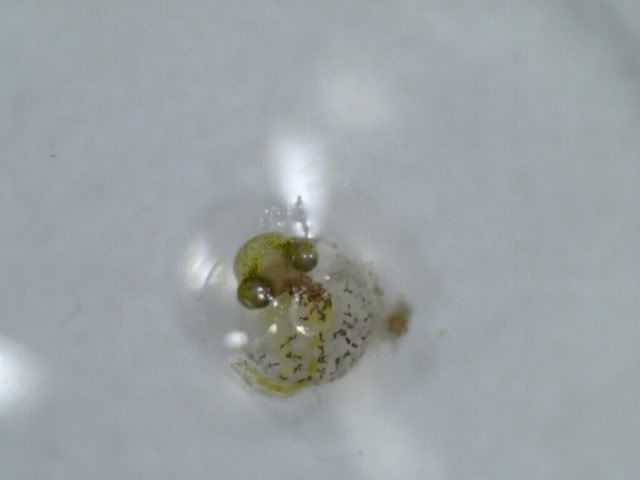
[color=red]Day 11[/color] All of three new developments I have catalogued above can be clearly seen in the above image.
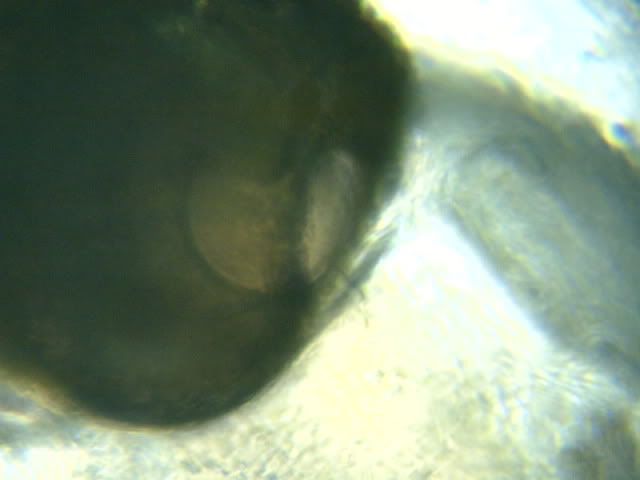
The eyeball is starting to form
http://www.youtube.com/watch?v=yuzK8ZP3d44#
The flow through the Oil Drop with the Heart bottom right
[url=http://www.youtube.com/watch?v=uId_aDJH_OA#]http://www.youtube.com/watch?v=uId_aDJH_OA#
The Heart Muscle is getting noticeably stronger and as from today has taken on a reddish pigmentation
If you would like to comment on any of the aspects of this work so far please feel free to do so. I mention this not as some kind of self gratification but by asking questions and interacting we all may learn something. I myself am keen to educate myself more on all aspects surrounding this subject matter, and there may be some learned friends out there who would like to offer up more information on the processes and development stages of this embryo.
Regards
C
Viewing inside the egg today I noticed a few new developments, The Oil Drop is getting decidedly smaller, The heart has taken on a reddish hue and at last the eyes are showing signs of shape and form.

[color=red]Day 11[/color] All of three new developments I have catalogued above can be clearly seen in the above image.

The eyeball is starting to form
http://www.youtube.com/watch?v=yuzK8ZP3d44#
The flow through the Oil Drop with the Heart bottom right
[url=http://www.youtube.com/watch?v=uId_aDJH_OA#]http://www.youtube.com/watch?v=uId_aDJH_OA#
The Heart Muscle is getting noticeably stronger and as from today has taken on a reddish pigmentation
If you would like to comment on any of the aspects of this work so far please feel free to do so. I mention this not as some kind of self gratification but by asking questions and interacting we all may learn something. I myself am keen to educate myself more on all aspects surrounding this subject matter, and there may be some learned friends out there who would like to offer up more information on the processes and development stages of this embryo.
Regards
C

Le 16 mai 2011 à 21h57

pascal17
Le 16 mai 2011 à 21h57
BigC
a écrit le 16 mai 2011 à 19h48 [b]What big eyes you've got[/b]
Viewing inside the egg today I noticed a few new developments, The Oil Drop is getting decidedly smaller, The heart has taken on a reddish hue and at last the eyes are showing signs of shape and form.
[color=red]Day 11[/color] All of three new developments I have catalogued above can be clearly seen in the above image.
The eyeball is starting to form
http://www.youtube.com/watch?v=yuzK8ZP3d44#
The flow through the Oil Drop with the Heart bottom right
[url=http://www.youtube.com/watch?v=uId_aDJH_OA#]http://www.youtube.com/watch?v=uId_aDJH_OA#
The Heart Muscle is getting noticeably stronger and as from today has taken on a reddish pigmentation
If you would like to comment on any of the aspects of this work so far please feel free to do so. I mention this not as some kind of self gratification but by asking questions and interacting we all may learn something. I myself am keen to educate myself more on all aspects surrounding this subject matter, and there may be some learned friends out there who would like to offer up more information on the processes and development stages of this embryo.
Regards
C
Je traduis (en gros) la fin du texte de notre ami Colin, au cas où certains souhaiteraient lui répondre en français:
"Sentez-vous libre de commenter tel ou tel aspect de ce travail en cours. Je dis cela non pour m'adresser un satisfecit personnel, mais parce qu'en échangeant et en posant des questions nous pouvons tous apprendre quelque chose. Je suis moi-même désireux d'améliorer mes connaissances sur ce sujet et il y a peut être parmi vous des amis un peu calés qui voudraient bien m'éclairer davantage concernant le processus de développement de l'embryon".

Le 16 mai 2011 à 22h01

BigC
Le 16 mai 2011 à 22h01
Pascal de Merci,
Je et devoir traduire au français, mais comme nous avons vu déjà parfois le message se perd, particulièrement quand je traduis :D
Je et devoir traduire au français, mais comme nous avons vu déjà parfois le message se perd, particulièrement quand je traduis :D
Vous avez besoin d'aide ?
Faîtes une recherche sur le forum
148257 messages, 7862 discussions pour répondre à toutes vos questions...

